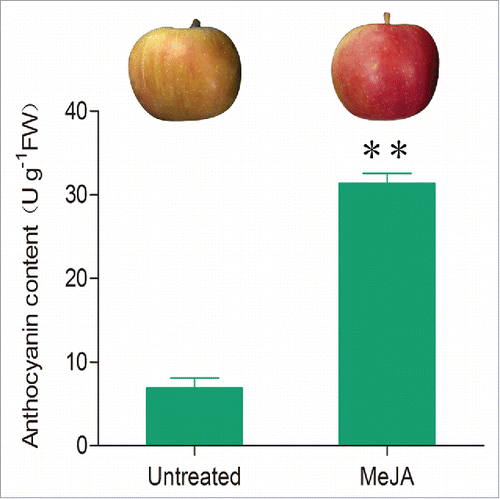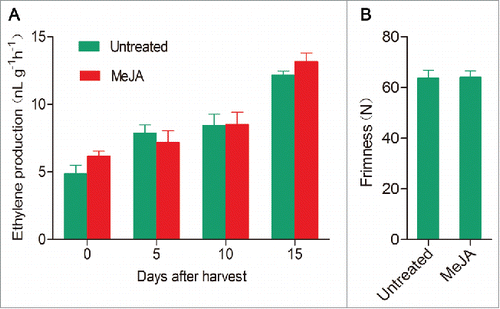ABSTRACT
Apple coloration is very important for most cultivars. The application of jasmonate can effectively enhance the coloration of apple fruit, but it might ruin the fruit's storage potential. Here, we report that applying methyl jasmonate on apple fruit 3 weeks before commercial harvest not only enhanced the fruit coloration but also did not affect its storage potential. Our findings provide important information for enhancing apple coloration using jasmonate.
Red peel color is a very important agronomic trait for many apple (Malus domestica) cultivars.Citation1 Poor red color development of the apple fruit surface decreases its attractiveness to consumers. Anthocyanin is responsible for the red coloration of apple fruit.Citation2 Its biosynthesis is affected by external cues, including light, temperature and nutrients as well as growth regulator.Citation1,Citation3-6 Ripening is another important trait for apple fruit, which determines the fruit's storage potential, especially in climacteric fruit.Citation7-9 Paclobutrazol, a gibberellin inhibitor, can markedly enhance red coloration while delaying fruit ripening. Both auxin and ethylene can also promote coloration, but they accelerate fruit ripening.Citation1,Citation10 It would be tremendously interesting to find a way to enhance the fruit's red color without affecting its ripening.
Jasmonate is another phytohormone that is used to enhance the red coloration of apple fruit.Citation4,Citation6,Citation11,Citation12 In some cases, the use of jasmonate can also enhance fruit ripening and can shorten the fruit's storage potential.Citation13 In the June issue of The Plant Cell, we reported that jasmonate promotes ethylene production by enhancing the transcription of MdACS1.Citation14 However, jasmonate-promoted ethylene biosynthesis is dependent on the expression of MdACS1, meaning that jasmonate is not able to promote ethylene production in apple fruit until MdACS1 expression has been initiated.Citation14 In apple fruit, MdACS1 is the key gene responsible for ethylene biosynthesis during fruit ripening.Citation15 MdACS1 is not expressed during fruit development but is specifically expressed during fruit ripening.Citation13,Citation16,Citation17 These results suggest that the application of jasmonate on apple fruit during development would not influence the ethylene production or fruit ripening. Interestingly, applying jasmonate during fruit development is effective in enhancing fruit coloration.Citation18
In this sense, it is possible to identify a certain period before fruit ripening when applying jasmonate not only enhances the fruit color but does not ruin its storage potential. To test this possibility, we treated apple fruit (M. domestica cv. Hanfu) with 10 mM of methyl jasmonate (MeJA) 3 weeks before commercial harvest, as described in Li et al.Citation14
After harvest, the fruit were subjected to an evaluation of their anthocyanin content and their storage potential. The anthocyanin was extracted from the fruit skin and measured, as described in Wang et al.Citation19 The result showed that the MeJA treatment significantly enhanced the anthocyanin content at the time of commercial harvest (). Interestingly, when fruits were stored at room temperature for 15 days, the ethylene production showed no significant difference between the MeJA treated and control fruits () during the storage period; meanwhile, fruit firmness was investigated at 15 d after storage, and it also showed no significant difference (). We also treated ‘Hanfu’ apple fruit with 10 mM of MeJA one week before commercial harvest; however, it did not obviously affect the anthocyanin content (data not shown). A previous study has obtained similar results, where anthocyanin content was significantly enhanced in the fruit by applying MeJA on ‘Cripps Pink’ apple fruit at 21 d before harvest; earlier applications worsen the effect.Citation18 Although Shafiq et al.Citation18 did not investigate the fruit's loss of firmness during the storage period, they have at least shown that the MeJA treatment does not affect the fruit's firmness at harvest compared with that of control fruits. Our findings in combination of the results from Shafiq et al.Citation18 strongly suggest that it is absolutely possible to enhance the anthocyanin content of apple fruit using MeJA 3 weeks before commercial harvest without influencing the fruit's storage potential.
Figure 1. Anthocyanin content of ‘Hanfu’ apple fruit with or without the application of methyl jasmonate (MeJA). Ten mM of MeJA was applied to apple fruit 3 weeks before commercial harvest. The fruits were collected at commercial harvest and subjected to measurement of their anthocyanin content as described in.Citation19 Three biological replicates were performed. Values represent means ± SE. Statistical significance was determined using a Student's t-test (** P < 0.01). Untreated, fruits without MeJA application; MeJA, fruits with MeJA application.

Figure 2. Ethylene production and firmness of ‘Hanfu’ apple fruit with or without the application of MeJA during storage. Fruits were collected at commercial harvest and stored at room temperature for 15 days. Fruits were sampled every 5 d, and ethylene production and fruit firmness were measured according to Tan et al.Citation20 A, ethylene production of apple fruit during storage. B, firmness of apple fruit at 15 d after storage. Three biological replicates were performed. Values represent means ± SE. Statistical significance was determined using a Student's t-test. Untreated, fruits without MeJA application; MeJA, fruits with MeJA application.

Moreover, we observed that the application of MeJA on the shaded side of the apple fruit did not obviously change the coloration (data not shown), suggesting that light is an important player in jasmonate-induced anthocyanin biosynthesis. It would be quite interesting to study the co-regulation of light and jasmonate on anthocyanin biosynthesis in apple fruit.
Disclosure of potential conflicts of interest
No potential conflicts of interest were disclosed.
Additional information
Funding
References
- Rudell D, Mattheis J, Fan X, Fellman J. Methyl Jasmonate enhances anthocyanin accumulation and modifies production of phenolics and pigments in ‘Fuji’ Apples. J Am Soc Hortic Sci. 2002;127:435–41.
- Sun BH, Francis F. Apple anthocyanins: Identification of Cyanidin-7-Arabinoside. J Food Sci. 1967;32:647–9. doi:10.1111/j.1365-2621.1967.tb00855.x.
- Gómez-Cordovés C, Varela F, Larrigaudiere C, Vendrell M. Effect of ethephon and seniphos treatments on the anthocyanin composition of starking apples. J Agr Food Chem. 1996;44:3449–52. doi:10.1021/jf960628m.
- Rudell DR., Mattheis JP. Synergism exists between ethylene and methyl jasmonate in artificial light-induced pigment enhancement of ‘Fuji’ apple fruit peel. Postharvest Biol Tec. 2008;47:136–40. doi:10.1016/j.postharvbio.2007.05.021.
- Ozturk B, Yıldız K, Ozkan Y. Effects of pre-harvest methyl jasmonate treatments on bioactive compounds and peel color development of ‘Fuji’ apples. Int J Food Prop. 2015;18:954–62. doi:10.1080/10942912.2014.911312.
- ÖZtÜRk B, ÖZkan Y, Yildiz K. Methyl jasmonate treatments influence bioactive compounds and red peel color development of Braeburn apple. Turk J Agric For. 2014;38:688–99. doi:10.3906/tar-1312-43.
- Gapper NE, McQuinn RP, Giovannoni JJ. Molecular and genetic regulation of fruit ripening. Plant Mol Biol. 2013;82:575–91. doi:10.1007/s11103-013-0050-3.
- Giovannoni JJ. Genetic regulation of fruit development and ripening. Plant Cell. 2004;16:S170–80. doi:10.1105/tpc.019158.
- Adams-Phillips L, Barry C, Giovannoni J. Signal transduction systems regulating fruit ripening. Trends Plant Sci. 2004;9:331–8. doi:10.1016/j.tplants.2004.05.004.
- Saure MC. External control of anthocyanin formation in apple. Sci Hortic. 1990;42:181–218. doi:10.1016/0304-4238(90)90082-P.
- Shafiq M, Singh Z, Ahmad SK. Pre-harvest spray application of methyl jasmonate improves red blush and flavonoid content in ‘Cripps Pink’ apple. J Hortic Sci Biotech. 2011;86:422–30. doi:10.1080/14620316.2011.11512784.
- Rudell DR., Fellman JK, Mattheis JP. Preharvest application of methyl jasmonate to'Fuji'apples enhances red coloration and affects fruit size, splitting, and bitter pit incidence. Hort Sci. 2005;40:1760–2.
- Kondo S, Meemak S, Ban Y, Moriguchi T, Harada T. Effects of auxin and jasmonates on 1-aminocyclopropane-1-carboxylate (ACC) synthase and ACC oxidase gene expression during ripening of apple fruit. Postharvest Biol Tec. 2009;51:281–4. doi:10.1016/j.postharvbio.2008.07.012.
- Li T, Xu Y, Zhang L, Ji Y, Tan D, Yuan H, Wang A. The jasmonate-activated transcription factor MdMYC2 regulates ETHYLENE RESPONSE FACTOR and ethylene biosynthetic genes to promote ethylene biosynthesis during apple fruit ripening. Plant Cell. 2017;29:1316–34.
- Dandekar AM, Teo G, Defilippi BG, Uratsu SL, Passey AJ, Kader AA, Stow JR, Colgan RJ, James DJ. Effect of down- regulation of ethylene biosynthesis on fruit flavor complex in apple fruit. Transgenic Res. 2004;13:373–84. doi:10.1023/B:TRAG.0000040037.90435.45.
- Li T, Tan D, Liu Z, Jiang Z, Wei Y, Zhang L, Li X, Yuan H, Wang A. Apple MdACS6 regulates ethylene biosynthesis during fruit development involving ethylene-responsive factor. Plant Cell Physiol. 2015;56:1909–17. doi:10.1093/pcp/pcv111.
- Wang A, Yamakake J, Kudo H, Wakasa Y, Hatsuyama Y, Igarashi M, Kasai A, Li T, Harada T. Null mutation of the MdACS3 gene, coding for a ripening-specific 1-aminocyclopropane- 1-carboxylate synthase, leads to long shelf life in apple fruit. Plant Physiol. 2009;151:391–9. doi:10.1104/pp.109.135822.
- Shafiq M, Singh Z, Khan AS. Time of methyl jasmonate application influences the development of ‘Cripps Pink’ apple fruit colour. J Sci Food Agric. 2013;93:611–8. doi:10.1002/jsfa.5851.
- Wang Z, Meng D, Wang A, Li T, Jiang S, Cong P, Li T. The methylation of the Pcmyb10 promoter is associated with green-skinned sport in Max Red Bartlett pear. Plant Physiol. 2013;162:885–96. doi:10.1104/pp.113.214700.
- Tan D, Li T, Wang A. Apple 1-aminocyclopropane-1-carboxylic acid synthase genes, MdACS1 and MdACS3a, are expressed in different systems of ethylene biosynthesis. Plant Mol Biol Rep. 2013;31:204–9. doi:10.1007/s11105-012-0490-y.
